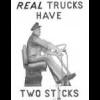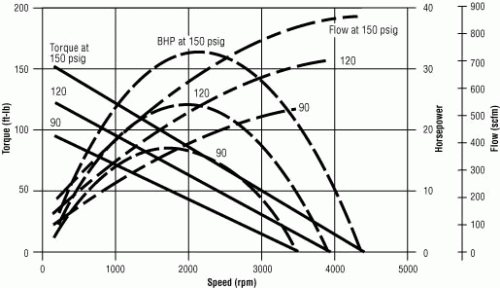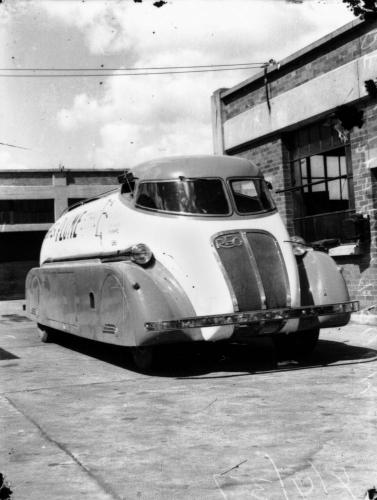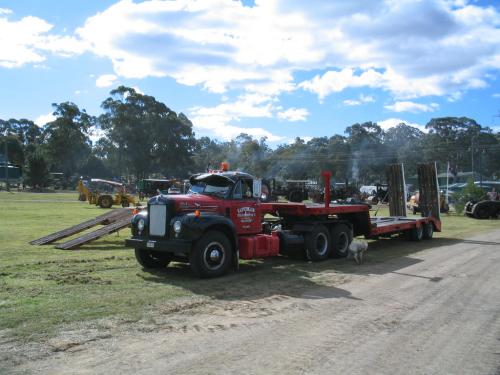-
Posts
250 -
Joined
-
Last visited
Content Type
Profiles
Forums
Gallery
Events
Blogs
BMT Wiki
Collections
Store
Posts posted by HeyCharger
-
-
Guys,
Anyone have any recent experience with getting new cab glass cut? Only good piece of glass I have is the back window. So I'm talking windshields, vent windows and door glass.
Hi Red Horse,
Just some info from DownUnder.
I got all my rubber (apart from front windshield, which I purchased through Barry) from a place here in Sydney, called Spectrum Rubber.
They have hundreds of different shapes and twists. Also Bailey Channel (for side windows). The twisty rubber parts were for the quarter vents (or wing windows)
If you are in the States, you must have a place similar. Some of your HotRod clubs would be able to help.
The rear screen rubber I got from the windscreen place that cut and installed front and rear glass.
So all the side glass, rubbers and bailey channel I installed myself. Easy.
Good luck. Rod.
-
I purchased a pair of mudflaps awhile ago and both of them have an arrow on them pointing IN.
Therefore, on mine, the dogs face IN.
Rod.
-
rod if you may have to get a higher horse power starter if 90psi is to low for you. i do remember that some time after the b model the horse power of the starter went in to doubel digets.
-Monty
Hi Monty,
My starter is a Ingersoll Rand 150BMP 32hp
http://www.irtools.com/airstarters/vane_guide.aspx
Regards,
Rod.
http://www.cvisairstarters.com/airstarters...lrand/150bm.php
and click on "150BMP Performance Curve"
So from this, you can see that initial air pressure is very important.
-
Hi Monty and Thad,
I'm in the same boat as you Monty.
Can't use the tyres to charge as I run mine at about 30psi (again like you bob-tailing).
I also thought about the 4wd compressor but disgarded the idea as I think it would burn out,.
I vaguely remember working out that the air start tank was around 200litres.
What I have done on the odd occasion is flag down a 4wd enthusiast for a recharge. They are friendly and helpful.
I will tell you a couple of tricks I use.
I've installed an electric fuel pump in line with the injector pump. So when I haven't started the old girl for awhile, I turn on the electric primer and wait until I have continuous flow back into the tank before attempting a start. I leave it on until about 2 minutes after the engine is started and then turn it off.
Afraid I'm too old to be head down - arse up priming for hours.
Secondly, and you may have seen this already, when you hit the air starter button, HOLD IT IN UNTIL either the engine fires or you run out of air, whichever occurs first.
If you want to deplete your air supply really quickly then just push and release - you may get about 3 attempts.
You mentioned 90psi. To me that is really low and with mine, it may not be enough for an attempt.
Look for air leaks - use highly concentrated soapy water sprayed on all the air supply lines etc.
Just remember the air supply for starting is very simple - tank, a couple of lines and starter. It should not be supplying pressure to anything else.
I've also put a VERY cheap air pressure gauge on the supply tank. Keeps me informed.
Hope this helps. Rod.
-
Reo truck with a tank capacity of 1075 Imperial gallons. The tyres were 7.50 x 20 therefore it was a chassis of nominally a 3 ton load. The company owning Plume petrol was Vacuum Oil Ltd.(now Mobil). Each mainland capital city had a similar streamlined Reo truck, but they were taken out of service by 1948 for a larger model.


-
Hi Guys,
If you are interested the dust is settling on another Guiness World Record achieved DownUnder.
Check out where it states the paddock is 3,500hectares. That's over 8,600 acres
Their farm is 20,230hectares (a mere 50,000 acres).
Go to; http://theland.farmonline.com.au/machinery/index.asp#
and then click on "FET 1" (351kb PDF).
Regards, Rod.
-
On another note, how difficult would it be to get either a permit, or license to drive an automobile in OZ, and NZ? Would it be money ahead to purchase a car while there as opposed to renting? It seems if I were to purchase, and have someone there broker the sale once departed, it might be less costly. I do plan to cover quite a bit of distance on the trip. What do you think?
Hi Rob, this may be of some help and I'm sure they can be issued in the USA.
http://www.aaa.com/PPInternational/Int_IDP.html
http://www.aaa.asn.au/touring/idp.htm
Buying a cheap, reliable car here is a very viable option if you are going to travel for awhile. I would suggest something like a 10 year old Ford Falcon, (aircon, auto etc) which could be purchased for $3-4,000 and then resold when you depart. (You are going back, aren't you????
 ).
).Regards, Rod.
http://www.carsales.com.au/used-cars/FORD/...amp;state_id=80
-
For info, my B61 bogey drive prime mover weighs 7tonne (~ 6.9ton or 15,400 lbs). Took it over a weighbridge to get accurate weight. Regards, Rod.
-
-
mozzie?..

Mosquito http://en.wikipedia.org/wiki/Mosquito
Absolute bastards! Carry LOTS of viruses.
Biggest ones I ever saw were in Russia. Fair dinkum, you could almost throw a saddle on them and ride them home.
-
Firstly, you must have water for your dog (yes, your faithful 4 legged mate). Also, your 3 red reflective breakdown triangles and I also carry vest AND waterproof, windproof parka which are dayglo lime colour with reflective strips. I've known so many people that have been wiped out by passing vehicles. Remember, safety is paramount. Then comes mozzie and fly repellent. Torch - yes.
Rod.
-
I add hydraulic oil to my dodge fuel tank and i fill like it is need in the new oil. I add 1 gal to 26 gtal of fuel and have since new. My 89 dodge has hyad atf added to it since new and sme pump on it now and it had 306000 miles on it and no pump failure but it needs replaced because it has a seal leaking when i parked it. I always cared a new fuel filter with me when using used motor oil.
Just confirming that you add ATF to the diesel and in what ratio?
Thanks. Rod.
-
The quad box shift levers in a B model always worked just fine for me in their stock configuration.
Hi Herb, I guess what I'm asking as well, is what was the standard configuration. Just about all have been "modified"

Rod.
Thanks Steve. For info, I'm just a little south of you, not the other side of the world

-
I'm curious as to the many ways the gear shift levers on a quad-box are bent.
Obviously a lot of drivers have their own personal preference.
I read somewhere that they should be so-arranged that you should be able to upshift into 3rd Lo-Split, with ONE HAND.
Comments, photos (preferably with mention of gears selected and ruler) appreciated.
Regards, Rod.
-
Hi Guys.
Two questions;
1) I've been told my rears are 44,000lbs. What does this actually mean to me as a driver? Does it mean that the actual trailer maximum weight is 44,000lbs ie approx 20 tons?
2) I've noted that the turntable (fifth wheel) on some prime movers is positioned differently. ie mine is very close to the centre of the two bogie axles. Others I've seen are positioned more forward (almost over the front bogie axle). Then there are the ones that slide forward or aft. What are the reasons/advantages?
Thanks. Rod.
-
Hi Monty,
No, it is not the original paint. It came out of the factory as a single drive painted green.
I have to admit that this is my own colour scheme and I must say, I still like it.
If you check out my gallery, you will see more.
Re Sydney, yes on RHS just after you go under Menangle Road and before you go under the Mark Evans bridge (I think).
I'm pretty sure I spoke to Ed at The NRMA Australia Day Motorfest, re your club.
I will put it on my calendar.
Where is your location? - Rod.
-
Hi Monty,
It was at our open weekend for the Campbelltown Steam & Machinery Museum.
Campbelltown is about 50km south west of Sydney.
We have a great time. Let me know if you would like further details.
Our next open weekend will be in Oct.
Here is a link to some photo's;
http://www.rstanford.com.au/rallies.html
Click on "Menangle Rally" columns show year and month.
Regards, Rod.
-
What a great weekend.
Good truck. Good dog (times two). Borrowed trailer. 8 traction engines. About 30 vintage tractors. About 20 vintage trucks. Dozens and dozens of stationary engines, some "hit-and-miss". Vintage cars.
Old drag-line bucket scoop and about 8 bulldozers - all operating. The smell of steam and oil.
Great weather and good friends. Heaven!!!
Rod.
-
This is what (little) I understand about chrome plating;
Chrome Process
1. Removal of Existing Plate
The first step in the restoration of chrome parts is the removal of all existing plating. To ensure a quality job the part must be brought down to its base metal. This is done by a chemical (acid) that removes the existing chrome and nickel plating.
2. Part Cleaning
After the plating has been removed, the parts are sand blasted clean, and/or chemically cleaned to remove rust. This process helps identify the flaws (pitting, scratches, rot) in the base metal that must be addressed.
3. Repair
For those parts that are deeply pitted or rotted, the chrome shop will either cut out and prefabricate the rotted area or will solder the flawed areas. Chrome shops have developed the skills and techniques required to address both the variety of metal and metal condition faced in restoring old metal parts.
4. Polishing
Using a series of abrasives the parts are polished to a near mirror like finish. Remember that your chrome shop has devised a number to techniques and tools that polish the metal without damaging the fine detail . This is especially necessary in the handling of the more delicate pot metal castings used in many older cars.
5. Copper Plating
After polishing the base metal the parts are copper plated. The copper plate both protects the metal and allows the chrome shop workers to buff the parts to a near flawless condition.
6. Buffing
The parts are removed from the copper solutions, rinsed and buffed. In the buffing process soft cloth wheels are used to remove small surface imperfections and to bring the parts to a mirror shine.
7. Nickel Plating
The parts are cleaned and immersed in a nickel plating tank. To insure a quality product platers continue to monitor the condition of the plating solutions. After approximately one hour the parts are removed with a brilliant nickel plate.
8. Chrome Plating
The final step of chrome plating gives protection and luster to your parts. It is the last step in the Triple Chrome Plating Process (1)Copper (2)Nickel (3)Chrome).
I believe that very few shops carry out step 5 Copper plating, for various environmental reasons. However, according to all the old timers, this is a very important step.
Try to find out if they are going to do the full Triple Chrome Plating Process.
Regards, Rod.
-
With due credit to Rob 22 Aug 07
Measure down 4 inches from the bottom of the steering wheel towards the dash and mark a line completly around steering column. Obtain reciprocating saw from toolbox and cut on line previously marked. Steering wheel comes right off effortlessly.
The solution is quite simple when you think about it.
Rob
I actually loosen the retainer nut till the top of the nut is flush with the ending of the column threads. I then place a large washer inside the steering wheel center, butt my knees against the wheel rim at the bottom while pulling at the top of the rim, and smack the washer with a hammer. The shock to the column usually breaks the wheel loose, and the retainer nut keeps you from eating the steering wheel.
Good luck!!
-
Hi Guys. I must have missed something along the way.
Why is an engine with a capacity of 672 ci called a 673?

No flaming please - just curious.
Thanks. Rod.
-
I can easily turn the engine over with a small bar on the flywheel, but it only goes about a quarter turn and then stops again. It turns back and forth in that 1/4 span fine but that is it. I don't hear anything at all when trying to turn it.
Hi Steve. I'm not a mechanic so this may be wrong.
When you turn it with the "small bar" you say it goes a quarter of a turn and stops. Is this a sharp, abrupt stop, or could it be just on a compression stroke. Just remember, the compression (I presume it's a diesel) is over 500psi. A normal car is around 80psi. When I've turned mine over, I've needed a BIG bar with plenty of leverage.
First thing I would do is take out a few (or all) injectors and then see if it turns easily, with no compression.
As has been said, you need a lot of ooommmppphhh to turn these over. Good batteries, or a good air supply are a must.
Hope this is helpful. Rod.
-
The air tank would be the biggest issue, as I was hoping to make room on the truck...not fill up MORE space LOL! Had thoughts of daisy chaining a few smaller round tanks(std issue stuff), and hang them under frame. I could hang two on each side of truck, one set where batteries were, and one set behind my diesel genset on drivers side. I know the more the better, but would have to work that out before going too far with it.
With all due respect, I don't think the multiple daisy chain effect would supply the air you need.
You need a large AMOUNT (ie volume) in a small time frame. I think the main supply hose from my one tank to the starter is about 2" diam. The solenoid control hose, on the other hand is about 1/2". I think my air tank is around 200litres (40-50gal) capacity.
You really need the OOMMMPPHHH! very big and very quick.
I must be lucky, because when I hit my starter, the old girl fires immediately (ie within 1 second).
Regards, Rod.
-
Ok.......stupid idea.........
Not at all. Hey Freightrain, finally going to join the elite, with an air-starter



A couple of tips;
1) When starting using air, hold the starter engaged until either the engine starts or you run out of air. Don't attempt a start, release, attempt another start, release, because you probably won't get another attempt

2) Have your air starter system and supply completely SEPARATE from ALL other air components, apart from ONE line where the air tank gets recharged and here use a one-way valve.
3) Before you start, look around the truck. If there are little old ladies, go and warn them before starting. If there are young kids/teenagers around - just hit the starter and enjoy the reactions

4) All fine and beaut to say you will use the air in the tyres to recharge the tank, and yes, here in Oz the working trucks still run at high pressure, but for me bob-tailing, I have at the most 30psi in the tyres

Therefore, when I have run out of air, I have flagged down 4WD's as a lot of these guys have compressors on board.
Enjoy one of the greatest sounds on earth.
Rod.








Ship Ahoy!
in Modern Mack Truck General Discussion
Posted
Hi Guys,
Check this out;
http://hcvc.com.au/forum/YaBB.pl?num=1218020067
Regards, Rod.